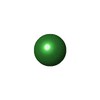+Search query
-Structure paper
| Title | Mosaic nanoparticle display of diverse influenza virus hemagglutinins elicits broad B cell responses. |
|---|---|
| Journal, issue, pages | Nat Immunol, Vol. 20, Issue 3, Page 362-372, Year 2019 |
| Publish date | Feb 11, 2019 |
 Authors Authors | Masaru Kanekiyo / M Gordon Joyce / Rebecca A Gillespie / John R Gallagher / Sarah F Andrews / Hadi M Yassine / Adam K Wheatley / Brian E Fisher / David R Ambrozak / Adrian Creanga / Kwanyee Leung / Eun Sung Yang / Seyhan Boyoglu-Barnum / Ivelin S Georgiev / Yaroslav Tsybovsky / Madhu S Prabhakaran / Hanne Andersen / Wing-Pui Kong / Ulrich Baxa / Kathryn L Zephir / Julie E Ledgerwood / Richard A Koup / Peter D Kwong / Audray K Harris / Adrian B McDermott / John R Mascola / Barney S Graham /   |
| PubMed Abstract | The present vaccine against influenza virus has the inevitable risk of antigenic discordance between the vaccine and the circulating strains, which diminishes vaccine efficacy. This necessitates new ...The present vaccine against influenza virus has the inevitable risk of antigenic discordance between the vaccine and the circulating strains, which diminishes vaccine efficacy. This necessitates new approaches that provide broader protection against influenza. Here we designed a vaccine using the hypervariable receptor-binding domain (RBD) of viral hemagglutinin displayed on a nanoparticle (np) able to elicit antibody responses that neutralize H1N1 influenza viruses spanning over 90 years. Co-display of RBDs from multiple strains across time, so that the adjacent RBDs are heterotypic, provides an avidity advantage to cross-reactive B cells. Immunization with the mosaic RBD-np elicited broader antibody responses than those induced by an admixture of nanoparticles encompassing the same set of RBDs as separate homotypic arrays. Furthermore, we identified a broadly neutralizing monoclonal antibody in a mouse immunized with mosaic RBD-np. The mosaic antigen array signifies a unique approach that subverts monotypic immunodominance and allows otherwise subdominant cross-reactive B cell responses to emerge. |
 External links External links |  Nat Immunol / Nat Immunol /  PubMed:30742080 / PubMed:30742080 /  PubMed Central PubMed Central |
| Methods | EM (single particle) / X-ray diffraction |
| Resolution | 2.01 - 8.0 Å |
| Structure data |  EMDB-7021:  PDB-5tr8: |
| Chemicals |  ChemComp-NI:  ChemComp-HOH: |
| Source |
|
 Keywords Keywords | IMMUNE SYSTEM / Nanoparticle / Ferritin / Antibody |
 Movie
Movie Controller
Controller Structure viewers
Structure viewers About Yorodumi Papers
About Yorodumi Papers




 Influenza A virus
Influenza A virus
